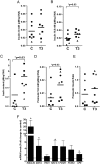MAFA and T3 Drive Maturation of Both Fetal Human Islets and Insulin-Producing Cells Differentiated From hESC
- PMID: 26207953
- PMCID: PMC4596039
- DOI: 10.1210/jc.2015-2632
MAFA and T3 Drive Maturation of Both Fetal Human Islets and Insulin-Producing Cells Differentiated From hESC
Abstract
Context: Human embryonic stem cells (hESCs) differentiated toward β-cells and fetal human pancreatic islet cells resemble each other transcriptionally and are characterized by immaturity with a lack of glucose responsiveness, low levels of insulin content, and impaired proinsulin-to-insulin processing. However, their response to stimuli that promote functionality have not been compared.
Objective: The objective of the study was to evaluate the effects of our previous strategies for functional maturation developed in rodents in these two human models of β-cell immaturity and compare their responses. Design, Settings, Participants, and Interventions: In proof-of-principle experiments using either adenoviral-mediated overexpression of V-Maf avian musculoaponeurotic fibrosarcoma oncogene homolog A (MAFA) or the physiologically driven path via thyroid hormone (T3) and human fetal islet-like cluster (ICC) functional maturity was evaluated. Then the effects of T3 were evaluated upon the functional maturation of hESCs differentiated toward β-cells.
Main outcome measures: Functional maturation was evaluated by the following parameters: glucose responsiveness, insulin content, expression of the mature β-cell transcription factor MAFA, and proinsulin-to-insulin processing.
Results: ICCs responded positively to MAFA overexpression and T3 treatment as assessed by two different maturation parameters: increased insulin secretion at 16.8 mM glucose and increased proinsulin-to-insulin processing. In hESCs differentiated toward β-cells, T3 enhanced MAFA expression, increased insulin content (probably mediated by the increased MAFA), and increased insulin secretion at 16.8 mM glucose.
Conclusion: T3 is a useful in vitro stimulus to promote human β-cell maturation as shown in both human fetal ICCs and differentiated hESCs. The degree of maturation induced varied in the two models, possibly due to the different developmental status at the beginning of the study.
Figures






References
-
- Kroon E, Martinson LA, Kadoya K, et al. Pancreatic endoderm derived from human embryonic stem cells generates glucose-responsive insulin-secreting cells in vivo. Nat Biotechnol. 2008;26(4):443–452. - PubMed
-
- Mitanchez-Mokhtari D, Lahlou N, Kieffer F, Magny JF, Roger M, Voyer M. Both relative insulin resistance and defective islet β-cell processing of proinsulin are responsible for transient hyperglycemia in extremely preterm infants. Pediatrics. 2004;113(3 Pt 1):537–541. - PubMed
Publication types
MeSH terms
Substances
Grants and funding
LinkOut - more resources
Full Text Sources
Other Literature Sources

